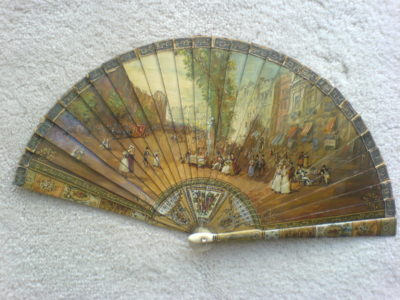À l’anglaise: A single leaf mounted so that the ribs are visible on the reverse.
À la cathedrale: A leaf with points at the top of each stick, resembling church spires.
À la sultane: A leaf that is mounted so that one or more sticks are visible on the obverse of the leaf.
Art Nouveau: Artistic style, characterised by its naturalism and sinuous shapes, that flourished between 1890 and 1920.
Art Deco: Post World War I artistic style inspired by the combination of traditional crafts with new developments in technology.
Baroque: Ornate style, characteristic of the period from approximately the mid 17th to the mid 18th century.
Burgo: Iridescent mother-of-pearl derived from the Turban Snail.
Canepin: Fine lamb or kid skin, or an imitation of them.

Cartouche: An illustration within a border on the leaf.
Catgut: Fine threads of a natural fibre twisted and treated with a stiffening coating, or synthetic material resembling it.

Celluloid: Early thermo-plastic.
Chicken skin: Fine skin, derived from uterine or young kid, treated to resemble high quality laid paper.

Chinoiserie: European artistic style influenced by Chinese art and wares that recurred at various periods between the mid 17th and late 18th centuries.
Clouté: Inlaid mother-of-pearl or semi-precious stones held with metal (gold or silver) thread.
Decoupé: Cut or stamped-out paper or skin, making a decorative pattern resembling lace.
Directoire: Artistic and fashion style typical of the last five years of the 18th century in post revolutionary France.
En camaïeu: A leaf painted entirely in shades of one colour.
Filigree: Ornamental tracery work of fine gold, silver or copper wire.
Goldfish: Yellowish iridescent mother-of-pearl derived from Haliotis shell (abalone).
Gouache: Water colour paint made opaque by thickening with gum or honey.
Grisaille: Painting in monochrome, usually in shades of grey.
Hiramaki-e: Sprinkled metallic powders coated with transparent lacquer (Japanese).
Japonisme: Late 19th century artistic style that was strongly influenced by Japanese art.
Leather: Animal skin (parchment, vellum, etc.) that has been treated and prepared to make a fine fan leaf.
Mica: Mineral with thin crystal layers that can be peeled off in fine transparent leaves.
Neo-classical: Late 18th and early 19th century artistic style based on the revival of the spirit and forms of classical antiquity.
Obverse/Recto: The front of the fan.
Parchment/Vellum: Animal skin treated to make a material suitable for writing or painting.
Paste: Imitation precious stones used for decoration.
Piqué: Inlaid gold or silver point work, usually found as decoration to tortoiseshell or ivory.

Print: Impressed image achieved by a variety of different processes, e.g. woodcut, etching, engraving, lithograph, chromolithograph and pochoir.
Putto/i: Chubby male child/ren in a work of art, usually naked and sometimes winged. A secular cherub.
Reserve: The outer parts of the leaf decorated with motifs separate from the principal design.
Rococo: Mid 18th century ornate artistic style characterised by its lack of symmetry and a frivolity absent from the Baroque that preceded it.

Reverse/Verso: The back of the fan.

Shibayama: Inlay work, often carved, applied to a base material from which it stands out in relief. Named after an 18th century family of Japanese craftsmen.
Spangle/Sequin: Small glittering metal shape. A sequin is circular.
Takamaki-e: Technique similar to hiramaki-e but with a raised surface (Japanese).
Tinsel: Glittering metal strips mainly used under the guardstick as a background for carving.
Trompe l’oeil: A painting that deceives the eye into thinking it is three-dimensional.

Vernis Martin: Imitation lacquer named after Guillaume and Etienne-Simon Martin who invented the process in the 18th century.

Vignette: Secondary illustration on the leaf.
